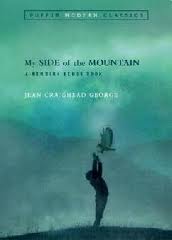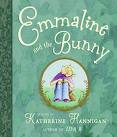My Side of the Mountain

by Jean Craighead George. ![]() Novel. 192 pages. Grades 4-7.
Novel. 192 pages. Grades 4-7.
Find this book: Amazon

Teacher's Guide

This classic, first published in 1959, was a Newbery Honor Book, an ALA Notable Book and is still a favorite.
Sam Gribley has run away from his large family in the city determined to live on his own on his great-grandfather's land in the Catskill Mountains of New York State.
Because the old homestead has long ago decayed to ruins this is a survival story of living in the woods on roots, fish, berries and nuts. Sam has done his research, mostly through books and uses his creativity to cook wild foods, to hollow out the base of a large tree for shelter, and to heat his home.
Frequently stretching credibility with Sam's flawless knowledge of how to live off the land, this is not a scary, tension filled tale of battling the elements. Although there are scary moments, this is a more Thoreau-like story of simplicity and self-reliance. It is full of appreciation of nature and of solitude.
Told in the first person---often quoting his journal notes---our narrator draws the reader from challenge to challenge in a way that captivates and draws us into the detailed descriptive passages. My Side of the Mountain is a satisfying fantasy of self-sufficiency.
(Continued Below)
Advertisement:

Things to Talk About and Notice
- Reading: Making Inferences:
Read the first few paragraphs. What is he (she?) saying? What does that imply? What's happening? What happens with the time setting? - Social skills: Empathy:
Sam's wants and needs are so different from the typical kid's. Can you imagine what it would be like to feel that way? Does the author help you to understand Sam's desires over the course of the book? How? - Reading: Themes:
Discuss together what might be some of the themes of this book. Brainstorm a list of specific details from the book that seem important such as that Sam wants to live alone in the woods. Help the students generalize these into themes. Some possibilities are survival, self-reliance, nonconformist goals, solitude, nature's importance, and our care of it. - Social Studies: Psychology:
At one point Sam writes, "I was writing more about the animals now and less about myself which proves I was feeling pretty safe." Is this outward focus a common symptom of feeling safe? Does fear tend to turn us inward? What have you noticed in yourself? In others? In other books?

Activities
- Social Studies and Science: Biomes. This novel is set in the Catskills. What kind of mountains are these? What type of biome is this? Within this biome there are three major categories. Which type are the Catskills? Where else in the world are similar biomes found? For the Catskills find high and low temperatures, average temperature, rainfall and snowfall figures. There are many online resources for this including,
http://www.ucmp.berkeley.edu/exhibits/biomes/forests.php - Social Studies and Language Arts: US History and Literature:
Bando calls Sam "Thoreau". Read about Henry David Thoreau. Make a chart of how Sam is like and unlike Thoreau. Read some of Thoreau's writings. See online resources below. - Language Arts: Writing:
Think about the research Jean Craighead George had to do to write this book. The care with which she writes about the details of living off the land makes me think she really enjoyed her research. Plan an essay about living off the land in your area. What would you need to know to complete it? What sources are available? What resources were available when George was writing? Gather the information your essay requires. Choose a time to make close observations of your environment in the style of Thoreau or Jean Craighead George. Take notes. Now write your essay. - Physical Education, Science and Math: Nutrition:
Calculate and then gather together non-processed foods to meet one child's one-day nutritional needs. Calculate how much you would need for one month, for one year. Calculate the volume of storage space you would need to keep this food.
(Continued Below)
Advertisement:

Related Books
- Baylor, Byrd. The Table Where Rich People Sit. Illustrated by Peter Parnall. (Atheneum, 1994. ISBN 0684196530.) Picture Book. Grades 2+.
Mountain Girl has had enough of being poor. She thinks her parentsshould change jobs so that they can have more things. What follows is a family meeting where they sit down and place a monetary value on the things they receive from their current work. Things like being able to work under the sky are valued at $20,000 per year. In the end they are already at "The Table Where Rich People Sit." This is a nice summation of many of Sam's values in My Side of the Mountain.  Emmaline and the Bunny by Katherine Hannigan. (2009, Greenwillow. ISBN 9780061626548. Order Info.) Chapter Book. 112 pages. Gr 1-3.
Emmaline and the Bunny by Katherine Hannigan. (2009, Greenwillow. ISBN 9780061626548. Order Info.) Chapter Book. 112 pages. Gr 1-3.
This chapter book uses a sweet approach to tell a cautionary tale of a town that doesn't allow any messiness. The consequences for one little girl effect her own quality of life as well as the wilderness environment. The writing is full of creative word usage and begs to be read aloud. A charming gem of a book. Read More.- Baylor, Byrd. The Other Way to Listen. Illustrated by Peter Parnall. (Scribner, 1978. ISBN 0684156512.) Picture Book. Grades
PreK+.
"I used to know an old man who could walk by any corn field and hear the corn singing." These first lines begin the quest of our girl narrator as she attempts to learn from the old man how to hear the natural world around her beyond the literal sounds to the unspoken spirit. - Armstrong, Jennifer. Shipwreck at the Bottom of the World: The
Extraordinary True Story of Shackleton and the Endurance. (Crown, 2000. ISBN 0375810498.) Nonfiction. Grades 5+.
This nonfiction title reads like a short novel (in spite of the copious use of photographs) because the story is so compelling. Stranded in Antartica in 1914 Shackleton and his men are immersedin a real story of survival. Very well written. - Thoreau, Henry David. Walden. (Houghton Mifflin, 1995 New Edition. ISBN 0395720427.) Nonfiction Adult. Grades 5+.
This adult classic is not accessible to all students but for some or in sections it definitely has it's place in any discussion of My Side of the Mountain. - Bishop, Nic. Forest Explorer: A Life-Size Field Guide.
Nonfiction. Grades 2+.
Very rich visually this book is perfect for browsing. Photographic manipulation was used to take these high resolution photos of various temperate forest creatures and make them into tableaus where you can see many life forms together in one two page spread. The following spread then takes the creatures separately and explains a little bit about them. The effect is reminiscent of the old science museum dioramas except that the animals here are alive not stuffed. - Tagliaferro, Linda. The Deciduous Forest. (Capstone, 2007. ISBN 0736864032.) Nonfiction. Grades 4+.
This very accessible nonfiction book is part of a series on various biomes. - Kurlansky, Mark. The Story of Salt. Illustrated by S. D.
Schindler. (Putnam, 2006 ISBN 0399239987.) Nonfiction Picture Book. Grades 3+.
This looks from the cover to be a picture book for young kids but in fact it's a great nonfiction book in disguise. Based on his best-selling adult book about salt, Kurlansky uses the picture book format to tell us the history of salt. I predict you will learn at least one totally unexpected fact. - Dowden, Anne Ophelia. The Blossom on the Bough: A Book of
Trees. (Ticknor & Fields, 1994. ISBN 0395683750.) Nonfiction.
Grades 4+.
Beautiful botanical drawings and inspiring writing bring this treatise on tree botany above the pale of normal nonfiction. The cover has a very feminine look which may make it more approachable for some but the extensive text is deeply scientific as well as philosophical. Not for the masses but if it catches a student just right it can be very absorbing. - Paulsen, Gary. Woodsong. (Bradbury, 1990 ISBN 0027702219.) Nonfiction Novel. Grades 4+.
Paulsen talks of his experiences in the North Woods especially about working with sled dogs. - George, Jean Craighead. On The Far Side of the Mountain (Dutton, 1990 ISBN 0525463488.) Novel. Grades 4+.
In this sequel to My Side of the Mountain we follow Sam as his mountain becomes more inhabited. Featured Book Teachers Guide with activities, related books and links. - Paulsen, Gary. Hatchet. (Simon & Schuster, 2007 20th anniversary edition, ISBN 1416925082.) Novel. Grades 4+.
This classic survival novel is more realistic than My Side of the Mountain. Brian, 13, is the only survivor in a plane crash in the Canadian wilderness. 
The Goats by Brock Cole. (2010, Square Fish. ISBN 9780312611910. Order Info.) Novel. 192 pages. Gr 5-9.
In this modern survival story Laura and Howie are the victims of a camp prank where a boy and a girl are stripped and left on an island in the lake. They are the Goats, chosen because of their inability to fit in. Laura and Howie decide to disappear both for revenge and because they don't want to return to the cruelty of the kids at the camp.
(Continued Below)
Advertisement:

Related Areas Within Carol Hurst's Children's Literature Web Site
- Free Teacher's Guides: A listing of all our teacher's guides. Picture Books, Nonfiction and Fiction.

Related Areas Elsewhere on the Internet
Following these links will take you off our web site. You will have to use your back button to return or, bookmark our site now so you can return anytime.
- Jean Craighead George's Website:
http://www.jeancraigheadgeorge.com/ - Missouri's Botanical Garden's Site about Biomes:
http://www.mbgnet.net/ - University of Wisconsin's Interview of Jean Craighead George:
http://www.education.wisc.edu/ccbc/authors/experts/george.asp - Ohio Division of Wildlife's Peregrin Falcon Website
http://ohiodnr.com/wildlife/dow/falcons/columbus.aspx - Iowa State University's Website on Thoreau
http://thoreau.eserver.org/ - San Diego County's Teaching Guide:
http://www.sdcoe.k12.ca.us/score/myside/mysidetg.html

